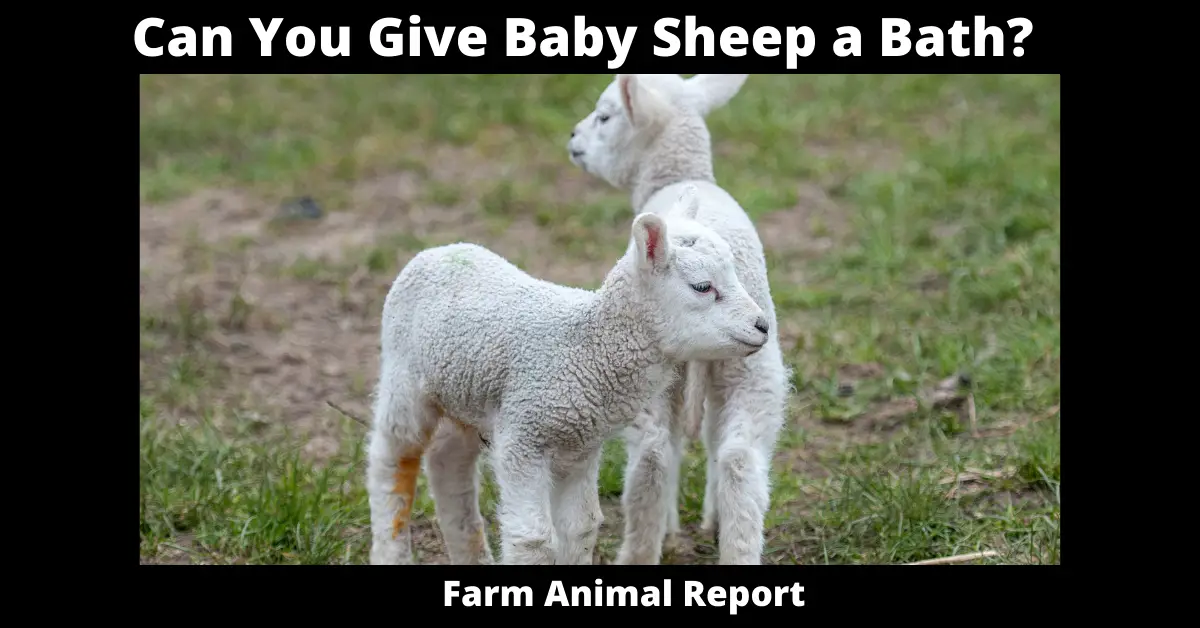As a general rule When raising a lamb, there is little grooming. We do not require daily bathing and blowing, as a show steer does, nor do we have the same concerns about skin and hair as a show pig does. Lambs, Baby Sheep do get bathed if they are being shown in Contest, fairs, and 4H rings.
Can You Give Baby Sheep a Bath?
Can You Give Baby Sheep a Bath? When raising a lamb, there is little grooming needed on the farm the mothers will keep the baby lamb clean.
Today’s fashions favor baby sheep with a larger bone structure and shaggier legs. While some baby sheep are genetically predisposed to have more, you can always assist in maintaining healthy hair and wool on their legs. This can be accomplished through routine washing and conditioning. After washing their legs, they must be brushed and dried. This practice can be repeated one time a week.
While we recommend washing your baby sheep’s legs, we do not recommend washing its body. This is to preserve their natural oils, called lanolin. Only when shearing with a fine or surgical blade, should you wash your baby sheep’s body. It is critical not to shear your baby sheep too frequently, as this will deplete their lanolin and degrade the freshness of their hide. Instead, shear your baby sheep once about a month.
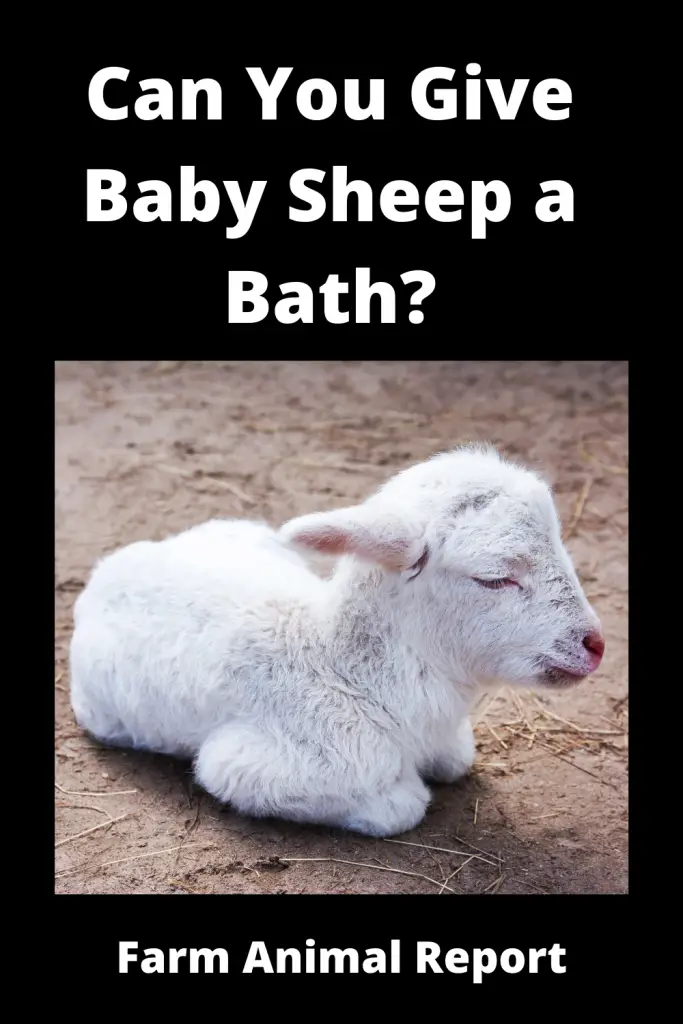
When shearing the hide with a fine or surgical blade, protect it with conditioners that promote natural oils. Additionally, it is recommended to provide a canvas blanket for the baby sheep with the hide exposed. This will help protect the hide from the elements, pests, and skin problems.
While grooming baby sheep, it is critical to maintaining proper hoof health. Trimming hooves at least once a month is ideal for keeping hooves healthy, especially if the baby sheep are on soft bedding or are kept in moist conditions. To maintain the natural cloven hoof, the hoof wall should be leveled and the toes trimmed.
How to Clean a Baby Lamb
Numerous newborn baby sheep are still lost during lambing season, and it is estimated that up to one in five lamb deaths may result from an unsanitary environment. On the other hand, maintaining proper hygiene should not be difficult and is a necessary component of any lambing season plan.
Before the ewes come inside to lamb, disinfect the lambing pens thoroughly with a DEFRA-approved disinfectant. Once the pen has dried out, prepare it for the new occupants by filling it with plenty of clean, dry bedding. Maintaining proper hygiene is also critical during lambing, and it’s well worth it to wear disposable, close-fitting protective gloves when lambing any ewes that require assistance.
Avoid confining lambing ewes in small pens to maintain the cleanest and driest bedding possible. To avoid mis-mothering and disease issues, any obvious wet straw and afterbirth should be cleaned out and fresh, clean straw provided between ewes. Lime in the bottoms of pens can also help to keep them dry and prevent disease problems.
How do you take Care of a Newborn Baby Sheep?
Nearly 20% of lambs perish before weaning. 80% of those losses occur within the first ten days. Therefore, proper baby lamb care can significantly increase the number of lambs raised in the flock by ewes. A more realistic target would be to keep lamb mortality between 4% and 5%.
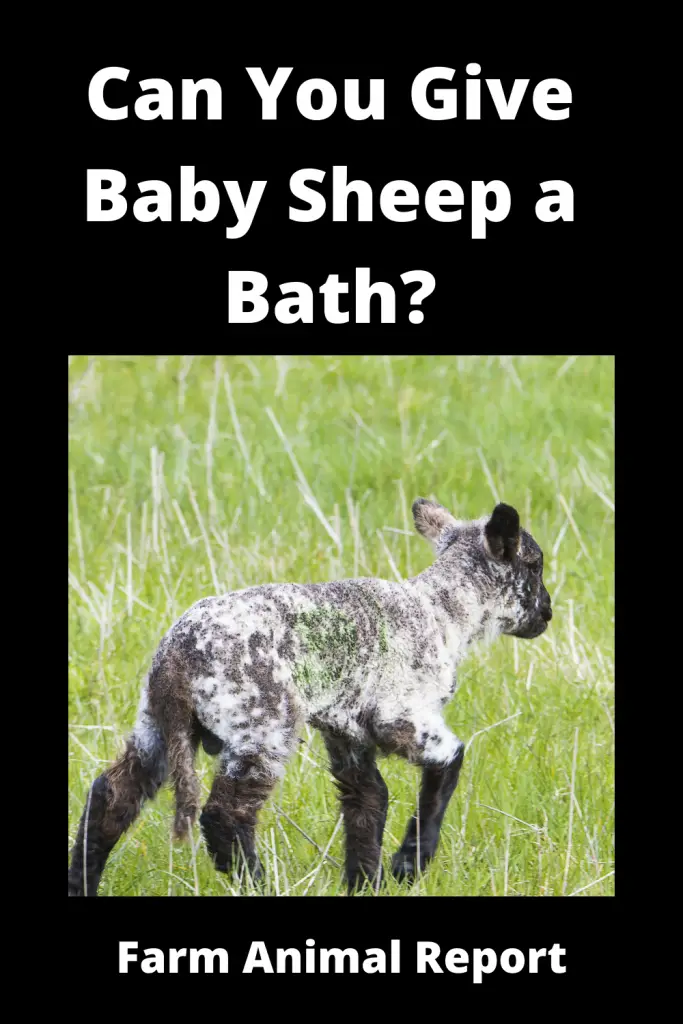
1. Lambing jugs (pens)
Once the ewe has delivered her lamb(s), she and her lamb(s) can be transferred to a lambing jug (individual pen). Lambing jugs aid in the bonding process and help to prevent mismothering. Soon after birth, the ewe’s udder should be examined for milk production and potential problems, such as mastitis.
Strip the teats to remove the wax plugs, though lambs can do so on their own. Lambs should be closely monitored to ensure they, nurse. When lambs have nursed, they will have a full stomach. Lambs that have not been served for an extended period should be assisted. Lambs that are small, weak, or malnourished may require assistance.
The size of the lambing jug can be adjusted according to the ewe’s size. The standard size is 5 x 5 ft. For larger sheep and multiple births, larger jugs may be required. Smaller jugs increase the likelihood of a ewe laying on her lamb (s). Clean, dry, and well-bedded lambing jugs should be used. Jugs should be cleaned between ewes if possible. Generally, one lambing jug per seven to ten ewes in the flock is sufficient. Additional lambs may be required if lambing is closely spaced. Suspend feed troughs and water buckets out of reach of lambs.
Caution should be exercised when using heat lamps. They should be used sparingly and hung at least three feet above the bedding in the pen’s corner. Lamb coats or jackets can be used in place of heat lamps. Lambing cubicles (4 ft. x 6 ft.) placed around the perimeter of the lambing area have been successfully used to house lambing ewes. Initially, they were used to prevent mismothering. Additionally, the research examined cubicles as a means of reducing labor requirements during lambing.
When ewes and lambs lamb on pasture, they are typically not jugged unless there is a problem. Occasionally, new lambers are housed in jugs, while mature ewes lamb on pasture or range. While pasture lambing requires less labor, it usually comes at the cost of increased mortality due to mismothering, predator, or weather-related losses.
See Our Extensive Guide – 16 Ways to Make Money Sheep Farming
2. Disinfecting Navels
The newborn lamb’s navel is a possible entry point for infectious agents. Cords that are longer than 2 inches should be clipped closer to the body. To prevent infection, navel stumps should be disinfected immediately following birth. Spray or dip the navel area in an antiseptic solution such as Gentle Iodine (1% iodine) or Chlorhexidine.
3. The Colostrum
It is the “first milk” produced by a ewe following lambing. Colostrum is a concentrated source of several nutrients critical for lamb health and performance. Additionally, colostrum contains a high concentration of antibodies against a variety of infectious agents. However, the lamb is born without antibodies, as antibodies in the mother’s bloodstream do not cross the placenta.
Lambs must receive adequate colostrum during their first 18 to 24 hours of life to ensure good colostral antibody absorption. Antibodies are large protein molecules that enter the lamb’s bloodstream during the first 18 to 24 hours of life. Therefore, the most efficient absorption of these antibodies occurs within the first few hours after birth.
Lambs should receive approximately 10% of their body weight in colostrum within 24 hours of birth. This means that a ten-pound lamb should consume one pound (16 ounces) of colostrum by the time it is 24 hours old. They should consume about half of this within four to eight hours of birth. Two ounces of colostrum is contained in a 60 cc syringe.
Colostrum is required for all lambs. While lambs can survive without colostrum in a disease-free environment, the risk of disease and death is significantly increased in lambs that do not receive colostrum. Therefore, colostrum from healthy ewes in one’s flock is the ideal source for supplemental feeding lambs. Ewes produce colostrum in varying quantities and quality. Young ewes generally have less colostrum due to their reduced milk production. Therefore, at lambing, ewes can be checked for the quality and quantity of colostrum (teats stripped).
Older ewes have been exposed to more infectious agents and typically have a higher antibody concentration in their colostrum.
Producers attempting to develop an Ovine Progressive Pneumonia (OPP)-free flock must be concerned about the source of colostrum, as OPP can be transmitted via colostrum from infected ewes to lambs. Cross transmission is also possible between goats (CAE) and sheep (OPP).
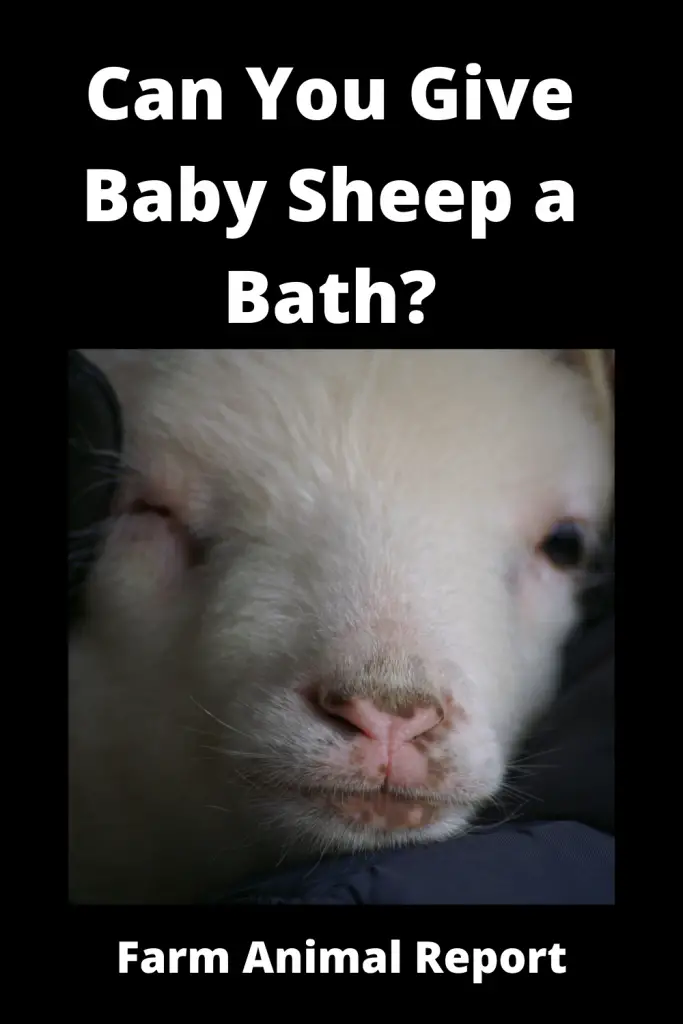
There are numerous lamb colostrum products available on the market. A substitute for colostrum contains immunoglobulins (IgG). Land O’Lakes sells a lamb colostrum substitute. The majority of the remaining products are colostrum supplements. These products are highly nutritious, but they are devoid of antibodies. Regardless, use a lamb-specific product.
4. Complications with Newborn Lambs
Starvation, hypothermia, scours, and pneumonia is the primary killers of newborn lambs. According to a study conducted at the United States Sheep Experiment Station (in Dubois, Idaho), 46% of baby sheep mortality is caused by scours (diarrhea), 20% by starvation, and 8% by pneumonia. In addition, lambs with prolonged and challenging birthing episodes and those that do not receive adequate colostrum are more susceptible to health problems.
5. Hypothermia
Hypothermia (cold) is a term that refers to a low body temperature. A newborn lamb must generate as much heat as it loses to the environment to maintain its body temperature. If it is unable to do so, its body temperature will begin to drop. A smaller lamb will cool down more quickly than a larger lamb. Lambs with thicker coats will retain heat more effectively. As a result, hair sheep lambs are generally more tolerant of cold temperatures.
The faster a ewe licks the lamb off, the less susceptible it is too chilling. Lambs born in drafty pens or outside without wind protection lose body heat more quickly. Lambs born in colder temperatures lose body heat at a faster rate than lambs born in moderate weather. Lambs suffering from hypothermia appear frail, gaunt, and hunched. The baby sheep may be unable to hold its head up in severe cases. It is possible for the ears and mouth to feel cold. The lamb may be deficient in its suckling response. Lambs have an average body temperature of 102-103°F. Lambs with a core temperature of less than 100°F are classified as hypothermic. Body temperature can be determined using a rectal thermometer.
It is critical to provide colostrum to newborn hypothermic lambs to raise their body temperature. Tube feeding is an efficient method of accomplishing this. Additionally, the lamb may need to be moved to a warmer environment to raise its body temperature. Indeed, if the lamb’s internal temperature is less than 99 degrees F, it should be warmed first. There are numerous methods for warming a lamb. Dry the lamb and wrap it in a towel if it is wet. To warm a lamb, a hairdryer can be used. A warming box can be used to place the lamb. Heat lamps are insufficient to keep hypothermic lambs warm. Additionally, they pose a fire hazard.
Hypothermia is typically caused by exposure in newborn lambs. Hypothermia occurs most frequently in lambs over 24 hours of age as a result of starvation. Older lambs should be handled similarly to younger lambs, except that they do not require colostrum. A bottle or tube feeder can be used to feed milk replacer. A greater quantity of milk should be provided at one time.
6. Starvation
Lamb starvation is the leading cause of infant lamb death. Numerous factors contribute to this condition: insufficient colostrum intake, dam rejection, mastitis, teats that are too large or too close to the ground, inadequate milk production, joint injury or illness, sore mouth, and difficult birth.
Typically, starvation occurs within the first three days of life. A lamb will either be found standing with its head bowed and its ears drooping back, or it will become too weak to stand. Lambs that are hungry frequently bleat. Palpation would reveal an empty stomach. Shivering, shaking, and hypothermia may ensue, but this hypothermic lamb is usually older than 12 hours. Nutrition is the obvious treatment for starvation. Particular lambs can be bottle-fed; others will require tubing.
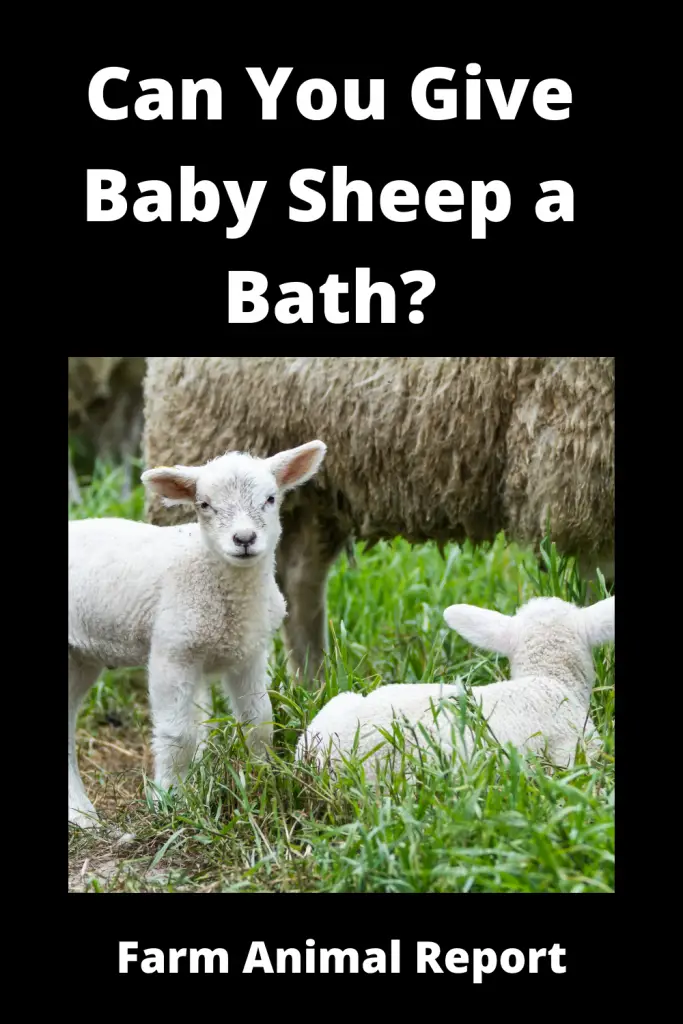
7. Scours (diarrhea)
Scours in newborn lambs can be caused by various bacteria, including e. coli, salmonella, or clostridium perfringins type C. Adequate colostrum consumption is the best defense against scours. Sanitation is also critical. Lambs born in unsanitary conditions are predisposed to a variety of potential health problems. Antibiotics and fluid therapy can be used to treat bacterial scours. The oral pig pump with spectinomycin is the preferred treatment for baby lamb scours. The extra-label use of this medication requires veterinary approval. Vaccines against e. coli scour (“watery mouth”) and clostridium perfringins type C are available.
8. Pneumonia
Pneumonia in newborn lambs is typically caused by the bacterium Pasteurella hemolytic but can occasionally be caused by mycoplasma. It is defined by fever, increased respiratory rate, inability to nurse, and, in severe cases, death. Lambs appear to be malnourished and lethargic. Lambs that do not receive an adequate amount of colostrum are particularly susceptible to pneumonia. Ventilation problems are frequently associated with pneumonia outbreaks. Drafts and dampness play a role.
Pneumonia is much more prevalent in housed sheep than in pasture-raised sheep. Barns that are tightly closed frequently lack adequate ventilation. Pneumonia is normally treated with antibiotics such as penicillin and tetracyclines. Fluid therapy can aid in the recovery process. Unfortunately, it has not been demonstrated that vaccination of pregnant ewes with parainfluenza (PI3) reduces pneumonia levels in newborn lambs.
What is the Best Creep Feed for Lambs?
The purpose of creep feeding is to entice lambs to consume food and thus promote weight gain. As a result, highly palatable feeds must be available. Baby sheep prefer feeds that are finely ground and have a small particle size when they are young. Soybean meal, ground corn, and alfalfa hay are all high-palatability feedstuffs for young lambs. To maintain freshness, these feeds should be replaced daily. A simple mixture of 80-85% ground or cracked corn, 15-20% soybean meal, and free choice high-quality alfalfa hay make an excellent early creep ration. The ewes’ feed may also be included freely in the creep feeder. Early in the creep feeding period, it is critical to maintaining a stimulating intake. These diets should contain a minimum of 20% crude protein.
11 Steps to Clean Adult Sheep?
When preparing to shear, we recommend a two-step washing and shearing strategy. Continue reading to learn more about how to shear your sheep in the cleanest and most precise manner possible.
- Blow out as much excess dirt as possible with a livestock blower.
- Wet the sheep thoroughly from head to tail to remove any remaining dirt, lanolin, or grime. If using water on the head and face, be sure to cover your ears.
- Utilize your hands to work in the Degreasing Shampoo.
- Rinse thoroughly until all soap is removed, taking care to close the ears and maintain a soft nozzle pressure.
- Conditioning Cream should be rubbed into the leg wool. Allow sitting for 5-10 minutes before rinsing.
- Blow-dry the body from the bottom to the top using both motors, leaving the body slightly damp. Leg Spray Comb into leg wool with a Mini Wide Range Brush. Permit this to stay in the legs.
- Now, using clippers and fine blades, perform a quick shear.
- Fill the bottom of a clean bucket with approximately 4 oz. It is brightening Shampoo and about 3-4 inches of water. As you fill the bucket with water, be sure to create a large amount of soap suds.
- Brush suds onto the hide with a soft bristle brush, working against the wool.
- Blow out the suds and loosen up any remaining wool with a blower.
- Shear again with a fine clipper or surgical blades.
Do you Wash Sheep before Shearing?
It is unnecessary to wash the sheep before shearing. Nobody does. After the wool has been sheared and skirted, it is washed to remove all vegetable matter and gross spots.
Do Sheep like to be Brushed?
Regular grooming is necessary to keep show sheep in top condition for competition. The grooming requirements for a sheep vary according to whether it is a market lamb or a breeding sheep. Grooming is also time-sensitive, as you want to clip or shear your animal a certain number of weeks before a show to ensure the wool has the desired appearance.
Brushing your goat daily may become a highlight of her day, feeding time excluded. First, remove mud and surface dirt from her with the stiff brush, then use the curry comb to remove any less obvious soil. Not only does vigorous currying bring dirt to the surface, but it also acts as a gentle massage. Finish with a soft brush that also aids in the distribution of oils throughout her coat. Next, feel your goat’s body with your hands to determine if she has any lumps or bumps. These could be wounds or an infestation of parasitic skin.
Why do Sheep need Haircuts?
Different breeds of sheep produce wool with a range of properties. Certain sheep have wonderful wool. Other sheep, on the other hand, not so much. Some sheep produce “hair” rather than wool, and this fiber is unique!
However, to obtain this wool, sheep must be sheared or shaved, similar to a haircut. Wool is the animal’s fiber (similar to hair or fur) distinct from the animal’s hide or skin. As a result, shearing or shaving sheep does not necessitate harvesting the animal. Indeed, the majority of sheep are sheared once a year throughout their lives.
What Happens if you don’t Shear Sheep?
Shearing must be practiced as long as there are sheep to ensure the health and hygiene of each animal. In comparison to other animals, the majority of sheep are unable to shed. When a sheep is not shorn for an extended period, several problems occur.
- Overwound wool impairs sheep’s ability to regulate their body temperatures. This can result in sheep becoming overheated and dying.
- Urine, feces, and other substances become entangled in the wool, attracting flies, maggots, and other pests. This causes irritation, infection and jeopardizes the animal’s health.
- Sheep with a lot of wool is more susceptible to predator attacks and can become immobilized by physical obstacles in their path.
Final Thoughts
Taking care of your sheep entails more than simply providing adequate food and water. Regular grooming not only strengthens the bond between you and your caprine companion, but it also has the potential to nip potential health problems in the bud or keep them from escalating. While grooming your goat, you’re also inspecting her skin, hooves, and the rest of her body.


